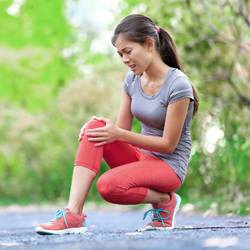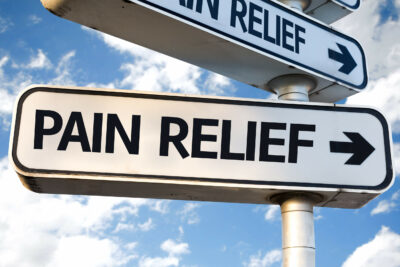Runner or Jumper’s Knee Relief

Runner or jumper’s knee, patellofemoral pain syndrome, is most common among people who participate in sports, especially females and young adults. The syndrome is characterized by pain and stiffness in the front of the knee and around the kneecap (patella), which can make it difficult to run, jump, climb stairs, and even perform everyday activities.
The knee is the largest joint in the body and is made up of the lower end of the femur (thighbone), the upper end of the tibia (shinbone) and the patella (kneecap). Muscles are connected to bones by tendons. The quadriceps tendon connects the muscles in the front of the thigh to the patella. The patellar tendon connects the patella to the tibia. Cartilage, synovium and bursae cushion and lubricate the knee joint to help bones glide smoothly against each other with leg movement. Patellofemoral pain syndrome occurs when nerves sense pain in the soft tissues and bone around the kneecap. In many cases, runner or jumper’s knee is caused by vigorous physical activities that put repeated stress on the knee like running, jumping, squatting, and climbing stairs. It can be aggravated by a sudden change in physical activity, such as increasing duration or intensity. Another factor that may contribute to patellofemoral pain syndrome is alignment or tracking of the kneecap.
Factors that contribute to poor tracking of the kneecap include:
- Problems with the alignment of the legs between the hips and the ankles
- Muscular imbalances or weaknesses, especially in the quadriceps muscles at the front of the thigh
Common symptoms of patellofemoral pain syndrome include:
- Dull, aching pain in the front of the knee
- Pain during exercise or sports activities
- Pain after sitting for a long period of time with knees bent
- Pain from a change in activity level, intensity, playing surface, or equipment
- Popping or crackling sounds in the knee with movement
What relieves runner or jumper’s knee symptoms?
- Stop doing the activities that make the knee hurt. Stop running and jumping.
- Change your training routine to low-impact activities to place less stress on the knee joint.
- Lose weight to reduce pressure on the knee.
- Implement the RICE method: rest, ice, compression, and elevation.
- Use non-steroidal anti-inflammatory drugs (NSAIDs) such as ibuprofen to help reduce swelling and relieve pain.
If the pain persists or it becomes more difficult to move the knee, contact DOC for a thorough evaluation. During the physical examination, he or she may palpate the painful area, check alignment for possible patellar tracking or alignment problems, and test strength, flexibility, stability, and range of motion. In addition to activity modifications and the RICE method, the DOC surgeon or PA may recommend physical therapy to strengthen and stretch the quadriceps to help stabilize the kneecap.
For more information on the cost of care, click here.




